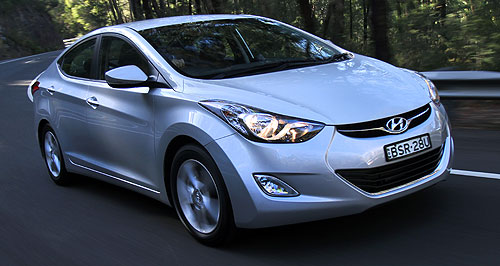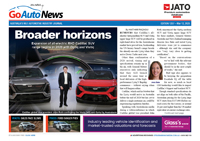Make / Model Search
New models - Hyundai - Elantra - sedan rangeFirst drive: Hyundai’s Elantra targets top-end small carsNew wave: Hyundai's chic Elantra is set to do battle with other upcoming new models including the Ford Focus, Honda Civic and Volkswagen Jetta. Hyundai hunts for greater small-car share with spacious, stylish, safer new ElantraGallery Click to see larger images 28 Jun 2011 HYUNDAI’S fifth-generation Elantra sedan has landed on Australian shores with a chic new look, larger than usual interior space for a small car, and a litany of safety and convenience features to rein in the high-flying Mazda3, Toyota Corolla and recently rejuvenated Holden Cruze. Kicking off from a competitive but by no means bargain-basement $20,590 for the entry-level Active 1.8 manual, the MD-series Elantra will also have to contend with a fresh wave of forthcoming combatants in the form of Ford’s LW-series Focus, Volkswagen Jetta ‘6’, Mk9 Honda Civic and Nissan’s Tiida replacement. Helping Hyundai Motor Co Australia’s desire for small-car domination is “Australian-tuned” suspension, a more powerful yet economical drivetrain, the brand’s five-year warranty and a five-star ANCAP crash-test rating across the range due to a full suite of active and passive safety features. The pricing makes the Elantra $600 more expensive than its outgoing HD-series equivalent, while sitting $1000 above its i30 SX 1.6 manual hatch sibling – although the i30 SX 2.0 also starts at $20,590. Automatic transmission adds $2000. Built off a new front-wheel-drive platform that will underpin a range of future Hyundais and Kias, the MD Elantra was styled in Irvine, California, and was previewed as the Avante almost 15 months ago at the Busan motor show in South Korea, before going on sale there in the latter half of 2010. Like its ix35 and i45 brethren, the styling reflects Hyundai’s current ‘fluidic sculpture’ design language. Dimensionally, the newcomer is 25mm longer (at 4530mm) and 50mm lengthier in wheelbase at 2700mm, but just as wide at 1775mm as before, with a height drop of 55mm to 1435mm. Despite the latter, the result is an interior that is roomier than more traditional mid-size sedans like the Honda Accord Euro, according to HMCA. Boot space is also rated at an extremely competitive 420 litres. As a point of comparison, the class-leading Mazda3 rests on a 2640mm wheelbase and measures 4580mm long, 1755mm wide and 1470mm high, while the Cruze has a 2685mm wheelbase, and length, width and height of 4597mm, 1788mm and 1477mm respectively. These figures show just how large the latest Elantra really is. Slightly lighter than the previous model, the MD Elantra tips the scales from 1277kg to 1289kg depending on the model variant. The front and rear tracks have also been widened, now 1563mm and 1576mm respectively. Under that snub bonnet is a 1.8-litre twin-cam four-cylinder petrol engine from the new ‘Nu’ family of powertrains, replacing the long-lived Beta II 2.0-litre unit used in the outgoing Elantra. It features what Hyundai calls D-CVVT (Dual Continuously Variable Valve Timing). Other technologies include an aluminium block and head, variable induction system, roller swing arm and hydraulic lash adjusters, electronic throttle control, and an offset crankshaft. It delivers 110kW at 6500rpm (5kW more power than the outgoing Elantra’s 2.0-litre engine) and 178Nm at 4700rpm. While peak torque is 8Nm less than before, the Nu 1.8 pumps out 30 per cent less hydrocarbon emissions, while noise, vibration and harshness properties are also reduced thanks to a maintenance-free silent timing chain system, according to Hyundai. Six-speed gearboxes step in for the five-speed manual and four-speed automatic offered in the previous car, with the new manual introducing a gearshift indicator and the auto offering an ‘ECO’ indicator both features are designed to encourage fuel-efficient driving. These measures, combined with the more efficient engine, reduced weight and improved aerodynamics (0.28Cd), result in claimed fuel economy savings of up to 11 per cent. Combined-cycle fuel consumption is 6.6L/100km for the manual (auto: 7.1), while the CO2 emissions rating is 158g/km (auto: 169). In contrast, the previous Elantra returned 7.4L/100km (auto: 7.8) and 175g/km (auto: 186). Fuel tank capacity is 48 litres. Being a car designed expressly for Asia and North America, no diesel engine is in the pipeline, although hybrid and even full-electric versions may be developed at a later date. Following Kia’s lead are special suspension and steering calibrations for Australian tastes, with some real-world testing on local roads resulting in unique front springs and front/rear shock absorbers, as well as revised mapping for the electrically powered rack and pinion steering’s control unit. Examples were shipped into Australia during January and February 2011. The suspension design layout – MacPherson struts and coil springs up front (with a 24mm anti-roll bar) and a coupled torsion beam at the rear – conforms to the class norm, although Hyundai says a three-point insulator design and bigger bushings than before aid in road noise insulation while a six-point cross-member reinforcement and a considered choice of tyre is said to increase rigidity and improve handling properties. All models include electronic stability and traction control (known as Vehicle Stability Management, or VSM), along with six airbags (front, front-side and side curtain), four-channel ABS brakes with electronic brake-force distribution, three-point seatbelts for all five occupants, front seatbelt pretensioners and load limiters, remote central door locking, an engine immobiliser, and an alarm system. Cruise control, Bluetooth connectivity and MP3 audio – with steering-wheel-mounted controls – are now standard on all models, while the more up-spec cars offer dual-zone air-conditioning, rain-sensing wipers, rear parking radar, push button start with a proximity key, front seat heaters and a sunroof. In some other markets the Elantra offers advanced technologies such as an automatic parallel parking system, Xenon headlights, LED tail-lights, puddle lamps, and heated rear seats, but these are not available in Australia for the time being. Also on offer abroad is a new-generation 1.6-litre direct-injection four-cylinder petrol engine producing 103kW and 167Nm, but there are no plans to offer this drivetrain in Australia. Standard wheels are 195/65 R15 on 15-inch tyres and steel wheels on the SX, moving up to 205/55 R16 alloys on Elite and 215/45 R17 alloys on the Premium grade. HMCA admits that supply constraints abroad – as usual the Elantra is made in South Korea, though US-market versions are to be assembled in North America – will limit the numbers it can sell in Australia. Currently there are a maximum of 650 units heading here each month. This situation should improve as Hyundai chips away at the 70,000-odd outstanding orders the MD-series has garnered over the last 12 months. Seven exterior colours will be offered, all against a black interior backdrop. Metallic paint adds $375 to the Elantra’s price. With the demise of the Sonata nameplate for the i45 mid-sizer last year, the Elantra has taken over the mantle as HMCA’s longest-running model name, stepping in for the nine-year-old Lantra nameplate when the third-generation XD series was released in October 2000. The MD could not come soon enough for Hyundai, with sales of the outgoing HD plummeting some 75 per cent so far in 2011 to just 237 units to the end of May, against the ageing i30’s 11,715. Last year a little over 2000 new Elantras were registered in Australia, a far cry from the XD Elantra’s 13,000-plus annual sales totals during 2004 and 2005. The HD could model’s best year was 7785 units in 2007 – the year the i30 was launched in Australia. While the i30 is expected to continue as the top-selling Hyundai in Australia (and number four overall in the small-car segment), a freeing up of supply should give HMCA a tilt at a podium finish against the ‘3’, Corolla and Cruze.
 Quick testsRead moreAll new models Alfa Romeo Alfa Romeo Abarth Abarth Alpine Alpine Alpina Alpina Audi Audi Aston Martin Aston Martin BMW BMW Bentley Bentley Chery Chery Brabham Brabham Chrysler Chrysler Chevrolet Chevrolet Cupra Cupra Citroen Citroen DS DS Dodge Dodge Fiat Fiat Ferrari Ferrari Foton Foton Ford Ford Great Wall Great Wall FPV FPV Haval Haval GWM GWM Honda Honda Holden Holden Hyundai Hyundai HSV HSV Isuzu Isuzu Infiniti Infiniti Jeep Jeep Jaguar Jaguar Lamborghini Lamborghini Kia Kia LDV LDV Land Rover Land Rover Lotus Lotus Lexus Lexus Maserati Maserati Mahindra Mahindra McLaren McLaren Mazda Mazda Mercedes-Benz Mercedes-Benz Mercedes-AMG Mercedes-AMG Mini Mini MG MG Nissan Nissan Mitsubishi Mitsubishi Pagani Pagani Opel Opel Porsche Porsche Peugeot Peugeot Ram Ram Proton Proton Rolls-Royce Rolls-Royce Renault Renault Saab Saab Rover Rover Smart Smart Skoda Skoda Subaru Subaru SsangYong SsangYong Tesla Tesla Suzuki Suzuki Toyota Toyota Volvo VolvoElantra pricingMotor industry news |
|
||||||||||||





























Facebook Twitter Instagram